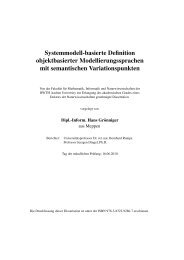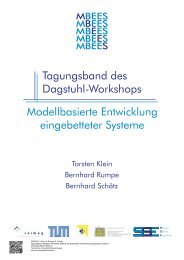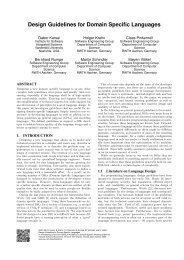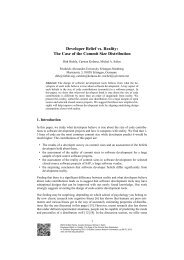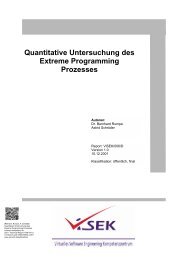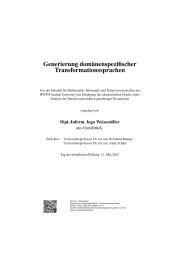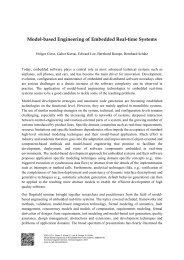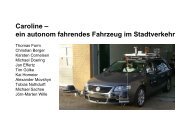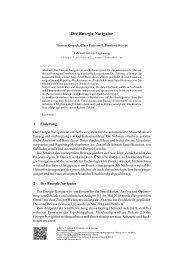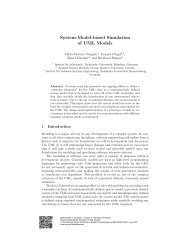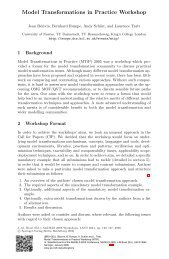Semantic Differencing for Activity Diagrams - Software Engineering
Semantic Differencing for Activity Diagrams - Software Engineering
Semantic Differencing for Activity Diagrams - Software Engineering
You also want an ePaper? Increase the reach of your titles
YUMPU automatically turns print PDFs into web optimized ePapers that Google loves.
Procedure 1 concrete-addiff(ad 1,ad 2)<br />
1: define queueP airs as queue of P air<br />
2: define visited, rejects as list of P air<br />
3: define traces as list of lists of P air<br />
4: <strong>for</strong> all ini 1 ∈ ad 1 .initials do<br />
5: foundCorresponding ← false<br />
6: <strong>for</strong> all ini 2 ∈ ad 2 .initials do<br />
7: if corresponding(ini 1 , ini 2 ) then<br />
8: add P air(−, ini 1 , −, ini 2 ) to queueP airs, visited<br />
9: foundCorresponding ← true<br />
10: end if<br />
11: end <strong>for</strong><br />
12: if not foundCorresponding then<br />
13: add P air(−, ini 1 , −, −) to rejects<br />
14: end if<br />
15: end <strong>for</strong><br />
16: visited, rejects ← traverse(ad 1 ,ad 2 )<br />
17: traces ← trace(visited,rejects)<br />
18: return traces<br />
Procedure 2 traverse(ad 1,ad 2)<br />
1: while queueP airs is not empty do<br />
2: p ← pair from queueP airs<br />
3: <strong>for</strong> all suc 1 ∈ p.cur 1 .successors do<br />
4: foundCorresponding ← false<br />
5: <strong>for</strong> all suc 2 ∈ p.cur 2 .successors do<br />
6: if corresponding(suc 1 , suc 2 ) then<br />
7: newP air ← P air(p.cur 1 , suc 1 , p.cur 2 , suc 2 )<br />
8: if newP air /∈ visited then<br />
9: add newP air to queueP airs, visited<br />
10: end if<br />
11: foundCorresponding ← true, break<br />
12: end if<br />
13: end <strong>for</strong><br />
14: if not foundCorresponding then<br />
15: add P air(p.cur 1 , suc 1 , p.cur 2 , −) to rejects<br />
16: remove all pair from queueP airs<br />
17: where p.cur 1 .inputs = pair.cur 1 .inputs<br />
18: end if<br />
19: end <strong>for</strong><br />
20: end while<br />
21: return visited, rejects<br />
where intermediate values from the fixpoint computation are<br />
used in the construction of a concrete winning strategy.<br />
Roughly, our symbolic algorithm starts with a representation<br />
of all non-corresponding states. It then moves ‘backward’,<br />
and adds to the current set of states, states from<br />
which there exists a successor in ad 1 such that <strong>for</strong> all successors<br />
in ad 2, the resulting successor pair is in the current<br />
set of states. Most importantly, to help in the construction<br />
of diff traces later, at each step backward, the algorithm remembers<br />
the newly computed set of added states. The steps<br />
‘backward’ continue until reaching a least fixpoint, that is,<br />
until no more states are added.<br />
When the fixpoint is reached, the algorithm checks whether<br />
the last computed set (the fixpoint set) includes initial states.<br />
For each such initial state, if any, the algorithm uses the<br />
sets of states computed during the backward steps to move<br />
<strong>for</strong>ward (from the minimal position it can start from) and<br />
construct shortest diff traces.<br />
We present our algorithm in general set notation, with the<br />
set-operations of union, intersection, and complementation.<br />
In the pseudo code below, sets with no subscript are sets<br />
of states over the union of all variables from ad 1 and ad 2.<br />
For i ∈ {1, 2}, sets with subscript i are sets of states over<br />
Procedure 3 trace(visited,rejects)<br />
1: <strong>for</strong> all rejectingP air ∈ rejects do<br />
2: define tr as list of P air<br />
3: curP air ← rejectingP air<br />
4: while curP air is not null do<br />
5: add curP air to tr<br />
6: if curP air.pred 1 is not null then<br />
7: curP air ←<br />
getV isited(curP air.pred 1 , curP air.pred 2 , visited)<br />
8: else<br />
9: break<br />
10: end if<br />
11: end while<br />
12: add tr to traces<br />
13: end <strong>for</strong><br />
14: return traces<br />
Procedure 4 symbolic-addiff(ad 1,ad 2)<br />
1: define traces as list of lists of Set<br />
2: define mem as array of Set<br />
3: mem ← least-fixpoint-with-mem(ad 1 ,ad 2 )<br />
4: if mem.last ∩ initials ≠ ∅ then<br />
5: traces ← build-traces-from-mem(ad 1 ,ad 2 ,mem)<br />
6: end if<br />
7: return traces<br />
the variables of ad i. The operator S| adi is used to restrict<br />
the variables of the set S to the variables of ad i (all other<br />
variables are existentially quantified out). The operation<br />
choose one relates to choosing a single element from the<br />
relevant set (a single concrete assignment to the variables).<br />
The sets corr and initials are the set of corresponding states<br />
and the set of joint initial states, respectively. When intersecting<br />
a set S i over the variables of ad i with a set S over<br />
the union of all variables from both ADs, the result is a set<br />
over the union of variables where the variables of ad i agree<br />
with their possible assignments in the set S i.<br />
In the implementation, the sets are represented using BDDs.<br />
A pseudo-code <strong>for</strong> the algorithm is given in Proc. 4, which<br />
uses Proc. 5 and 6.<br />
Note that in the final iteration of the loop in Proc. 6,<br />
reached with i = 1, the assignment to next 2 is guaranteed<br />
to set next 2 ← ∅, because the first location in the memory<br />
array equals corr. This guarantees that the last state in each<br />
diff trace assigns no values to the variables of ad 2: indeed,<br />
the last ad 1 state in the trace should have no corresponding<br />
ad 2 state in the trace.<br />
If the user is interested only in checking the existence of<br />
differences but not in the set of all witnesses, we can stop<br />
the steps backward as soon as the set of added states includes<br />
an initial state (by checking whether p ∩ initials = ∅<br />
already after line 9 in Proc. 5). In some cases, as our evaluation<br />
shows (see Sect. 6), this is indeed much faster than<br />
waiting <strong>for</strong> the fixpoint to be reached and <strong>for</strong> all traces to be<br />
enumerated. Note that trace enumeration is not symbolic<br />
and thus may not scale well.<br />
Finally, <strong>for</strong> both algorithms, the concrete and the symbolic,<br />
correctness and completeness are proved by induction<br />
on the length of the traces and rely on the fact that the ADs<br />
are internally deterministic.<br />
5. IMPLEMENTATION AND USES<br />
We have implemented addiff and integrated it into a prototype<br />
Eclipse plug-in. The input <strong>for</strong> the implementation are



